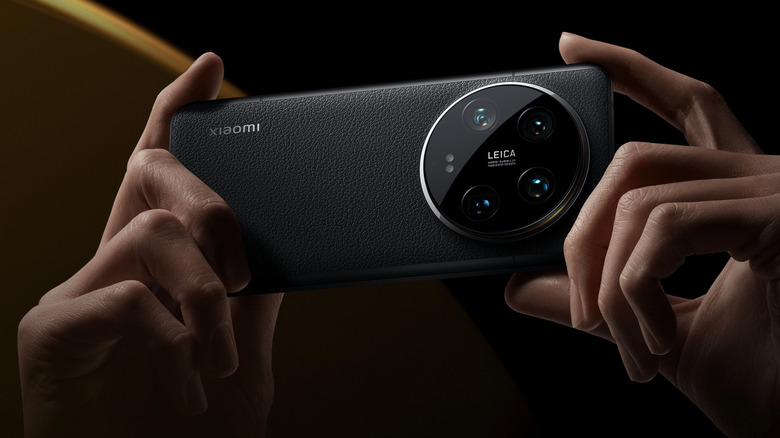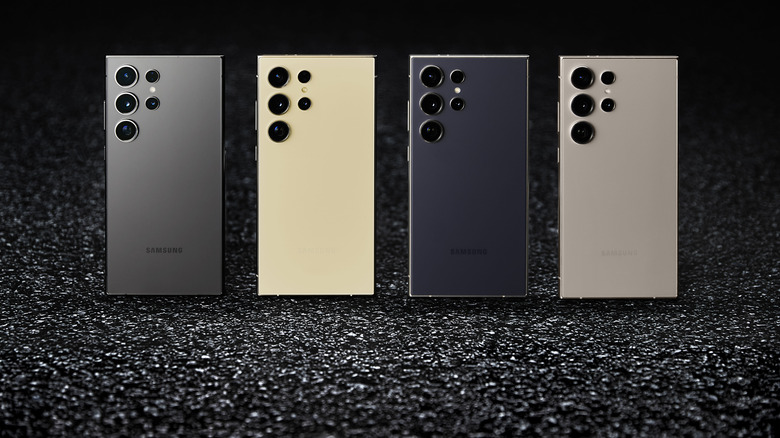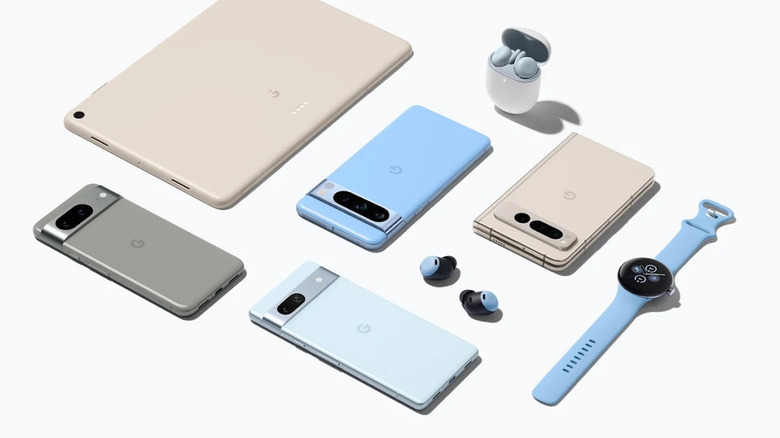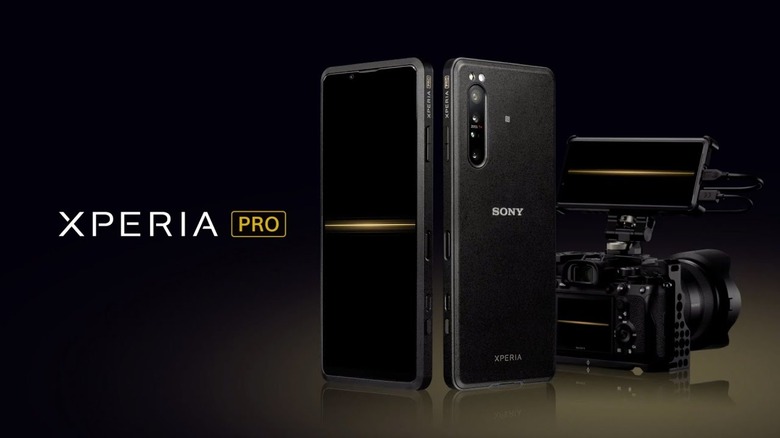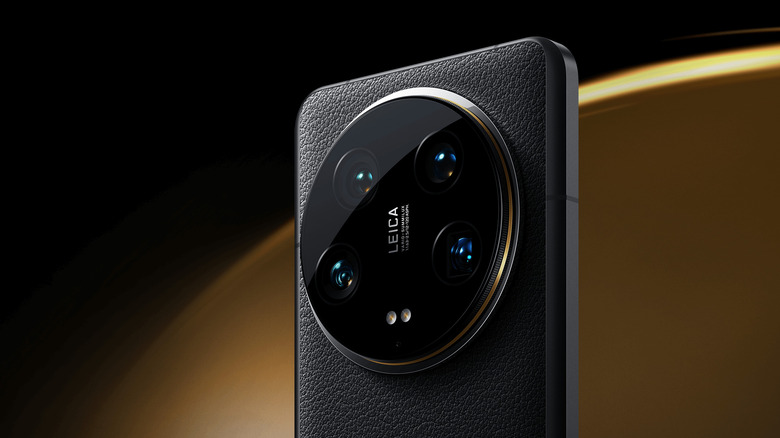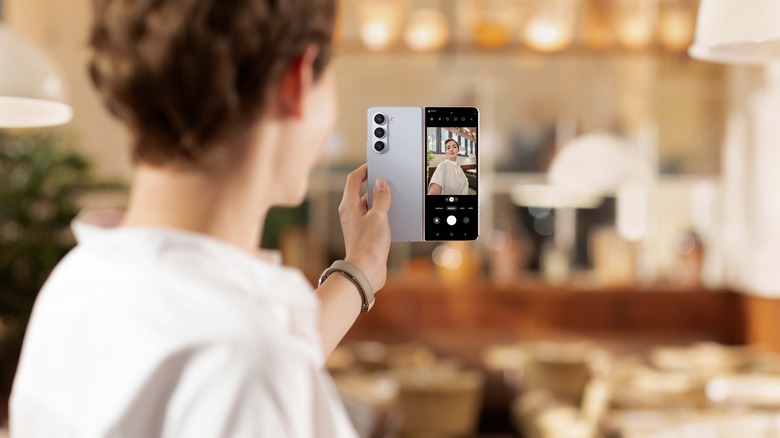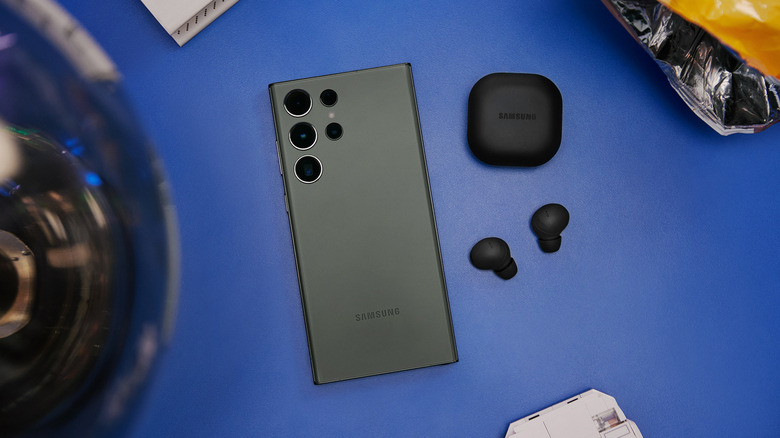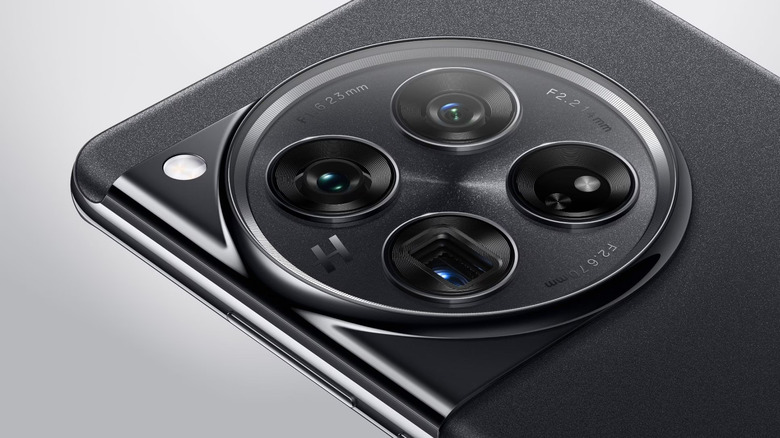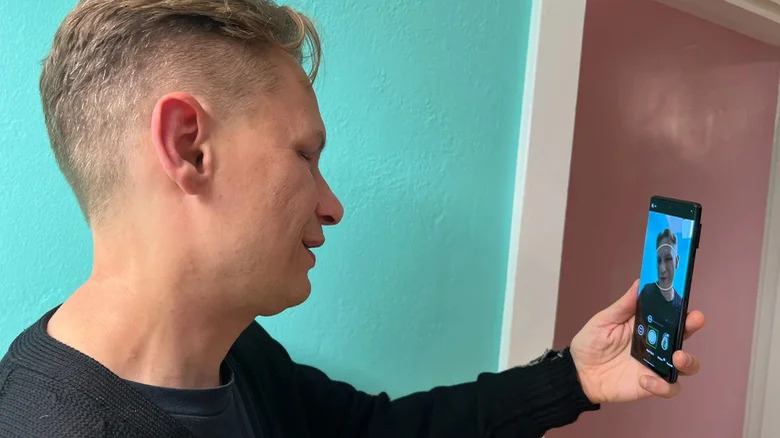8 Camera Features Android Phones Have In 2024 That Set Them Apart
Smartphone cameras have become the latest arms race in tech, as companies try to dethrone the competition with bigger, better, beefier cameras each year. Having access to a greater variety of camera features is one of the top reasons why some people prefer Android phones. Just take a look at the ever-expanding camera modules on the most popular phone brands year over year. Samsung went from cameras that were almost flush with the chassis to phones like this year's Galaxy S24 Ultra, which brandishes camera rings like brass knuckles. The latest Pixel phones have a Geordi-LaForge-style visor to house their imaging sensors. And Xiaomi's newest flagship, the 14 Ultra, isn't a smartphone with a camera — it's a camera with a smartphone attached.
In this hypercompetitive world of ballooning megapixel counts and massive modules to house them, every Android manufacturer is trying to stand out. Sometimes, these efforts amount to nothing more than gimmicks, but others are truly useful innovations that the competition will no doubt copy next year. Let's look across the smartphone landscape to see who's got the most unique and interesting photography features for shutterbugs. From extreme zoom capabilities and foldable shooting modes to mechanical apertures and specialized software features to capture the far reaches of space, here are the most unique Android camera features currently available.
Galaxy S Ultra series: Space Zoom
In 2020, Samsung added a new top-tier Ultra model to its Galaxy S lineup. Beginning with the Galaxy S20 Ultra, these phones distinguished themselves from the cheaper Galaxy S phones primarily through their cameras. Not only do they boast massive megapixel counts — the latest Galaxy S24 Ultra boasts a 200MP main sensor — but they also come with zoom cameras that can crop in up to 100X. Samsung calls this capability Space Zoom, and it has remained the most extensive zoom on a smartphone.
In fact, Space Zoom is so impressive that it can feel a bit shocking at first. The ability to zoom in so far that you can clearly read text on a sign multiple blocks away feels like a superpower. But while it's useful for reading signage, getting a better look at wildlife, or even capturing a halfway decent photo of the moon, the quality of photos shot with Samsung's Space Zoom falls off heavily after about 30X. Photos zoomed in at 100X are too grainy to be of much use. Still, 30X is plenty of reach, and being able to take a halfway decent photo at that length is a capability that sets Samsung's Ultra phones apart from the competition.
Google Pixel series: Astrophotography mode
Every flagship Android phone these days has a night mode that makes photos shot in the dark look better, so for the Pixel 7 and 8, Google took things a step further by adding an Astrophotography mode that lets you capture the night sky. The mode is built into the Night Sight mode of the Pixel Camera app.
To use Astrophotography mode, Google suggests traveling away from the city and waiting until complete darkness. Due to a phenomenon called light pollution, it can be difficult to see the stars when you're near a city or other population center, and that's true for both your phone and your own two eyes. Additionally, the Pixel Astrophotography mode works best when your phone is completely still, so it's recommended to place it on a tripod or prop it up in some other fashion.
Once the Pixel's Night Sight mode recognizes that the camera is looking at the night sky, it automatically switches into Astrophotography mode. When the shutter is pressed, it takes a long exposure shot with a timed countdown, then applies post-processing to enhance the sky within the image. While this feature might not be useful most of the time, it's definitely something to remember for Pixel owners who love to go camping, making the Pixel 7 or 8 a great addition to your collection of useful camping gadgets.
Sony Xperia series: Xperia PRO
Would you pay $2,500 for a smartphone? Sony wagered someone would when it launched the Xperia PRO, a phone meant for professional photographers. As one of the leading manufacturers of camera equipment, Sony knew that people who had already dropped up to $6,000 on a high-end camera wouldn't balk too much at another couple grand for a phone that worked as a camera accessory.
The phone itself has a relatively normal camera by Sony standards, or even by modern smartphone standards. It's a triple camera array, each of which is a 12MP Sony sensor behind a Zeiss lens. But the Xperia PRO wasn't designed with its built-in cameras in mind. As professional photographer Darren Carroll explained in a promotional video for the phone, he can connect the Xperia PRO to his Sony Alpha 7S III with a tethered USB-C connection and HDMI. While he takes pictures, the phone transmits them to the cloud. He also demonstrates using the phone as a secondary monitor that can be positioned on a separate tripod. In the same video, a couple who run a YouTube channel demonstrate connecting the Xperia PRO to a Sony video camera for high-quality live streaming.
Unless your full-time job is photography, you're probably not the target market for the Xperia PRO, and even then, it works best with Sony's own cameras. Nonetheless, it's sold out on Sony's website at time of writing. Apparently, Sony knows who its customers are.
Xiaomi 14 Ultra: Leica 4-lens camera array
Over the years, smartphone camera bumps have become gargantuan, to the point where many popular phones rock back and forth when laid on a table. Xiaomi looked at that and said, "Not big enough." Its latest flagship, the 14 Ultra, is a collaboration with old-school camera company Leica. It's an array of four lenses, with the main camera being a 1-inch Sony sensor with a mechanically adaptive aperture. Although 1-inch sensors are showing up on more smartphones these days, they're not the norm and have traditionally been found on professional cameras.
The aperture borrows an idea we saw from Samsung a few years back with 2018's Galaxy S9+. But whereas Samsung's implementation only allowed the aperture to shift between f/1.5 and f/2.4, Xiaomi's beastly design is continuously variable from f/1.63 to f/4.0, making it much more adaptable.
As with a lot of collaborations between smartphone manufacturers and legacy camera companies, the Leica color science only goes so far, but reviews seem generally impressed by the cameras. As for the additional branding, the camera's Leica Authentic Mode makes photos taken with the 14 Ultra look less like smartphone photos and more like the results you'd get from its own classic M series film camera.
Not content with the Xiaomi 14 Ultra's impressive standalone camera array, the company took things a step further, introducing a Photography Kit that adds a case and a camera grip with an external battery pack and physical button controls. It even has zoom dial for transitioning smoothly between camera lenses.
Galaxy Z series: main-camera selfies and more
Although brands like OnePlus and Motorola are catching up to Samsung — making it worth waiting before grabbing a foldable — the Korean giant has led the charge with its Galaxy Z Fold and Z Flip smartphones. Accordingly, it equipped those devices with some unique camera features. Since foldable phones have outer screens to make them useful when folded, unfolding them allows you to use the high-quality main cameras for selfies while using the outer display as a viewfinder. Most front-facing selfie cameras have far fewer megapixels than their corresponding main shooter. Being able to line up a selfie with the better cameras means higher-resolution shots of your smile.
Of course, other foldables have implemented this feature as well — it's become a core part of the foldable experience. Many foldables also take advantage of their form factors to act as makeshift tripods. While not all can be adjusted to any angle within the radius of their fold, Samsung's can: Both the Z Flip and Z Fold line can be partially unfolded and placed on a flat surface, leaving the main cameras still pointed toward the subject. Using an S Pen, a Bluetooth remote, or one of the many other Galaxy camera features that allow hands-free shooting, you can then take a photo with perfect stabilization.
Samsung even added astrophotography to the Z Fold 4 and 5. And since the Z Fold can be its own tripod, the feature makes even more sense here.
Galaxy S and Z series: 360 audio recording
Samsung makes multiple appearances on this list because few other companies have crammed the sheer number of camera features into their phones as the Korean giant. One relatively new addition is the ability to record video with spatial audio when you're wearing a pair of Galaxy Buds2 or Buds2 Pro. When playing the footage back on a device that supports 360 audio, you'll hear all the sound directionally. It's kind of uncanny to feel auditorily transported back to the moment you took the video. A bump or knock that sounds like it's actually coming from behind you is startling enough to make you check that no one is sneaking up on you.
Unfortunately, 360-degree audio recording is limited to the Galaxy Z Flip 4, Z Flip 5, Z Fold 4, Z Fold 5, and Galaxy S23 series. If the feature works on Samsung's latest S24 series, the company's website hasn't been updated to reflect that at time of writing. Additionally, using the feature means giving up on another great Samsung camera feature — the zoom-in microphone, which picks up directional audio based on where you zoom when shooting video.
To use 360-degree audio recording, connect your compatible Galaxy Buds to a compatible Galaxy phone, open the camera, and tap the gear to open camera settings. Tap Advanced video options and tap the toggle for 360 audio recording.
OnePlus 12: RAW Plus
OnePlus's latest phone, the 12 Pro, borrows from its sibling company, Oppo, with an enthusiast camera feature called RAW Plus. RAW photos are uncompressed, lossless files favored by professional photographers. However, their large file size and lack of post-processing make them unideal for those who want to quickly snap and post a photo. With RAW+, the OnePlus 12 takes a RAW photo that also has its computational processing pipeline applied. This has the advantage of making the file immediately usable but also editable in professional software.
The reason for this feature is that you might want one version of a photo to quickly post on Instagram and another to edit for professional use. Unfortunately, OnePlus seems to have strangely limited the scope of this feature, forcing users to accept binned 12.5MP shots in RAW Plus mode, a puzzling limitation for a professional file format. Even the iPhone has a ProRAW feature these days, so these limitations have rendered the OnePlus 12's RAW Plus mode comparatively less useful than it ought to be in the eyes of some reviewers.
Google Pixel series: Guided Frame
Accessibility in tech is one of the most important aspects of innovation. While our digital world has made life exponentially easier for abled people, those with disabilities often struggle to use technology that wasn't designed with them in mind. Android has, over the years, developed a robust suite of accessibility features, but those don't really extend to the camera. Low-sighted and blind people often experience difficulties taking photos on their smartphones, so Google introduced the Guided Frame feature on Pixel phones to assist. The feature uses audio cues to help vision-impaired individuals take selfies by instructing the user where to move the phone to keep them in the frame.
When holding the phone in front of your face, Guided Frame speaks instructions aloud, saying things like, "Move your phone up and to the left." Once the user is correctly positioned within the frame, the phone vibrates in addition to confirming that it's time to take a selfie. Then, a three-second timer begins with a countdown to take the photo.
According to Google technical programmer Lingeng Wang, the idea for Guided Frame came from working directly with blind people. "We were focused on the wrong solutions: telling blind and low vision users where the front camera placement is," he said in a blog post. "After we ran a preliminary study with three blind Googlers, we realized we need to provide real-time feedback while these users are actively taking selfies."
